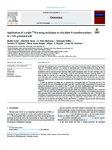Application of a triple <sup>15</sup>N tracing technique to elucidate N transformations in a UK grassland soil
| dc.contributor.author | Loick, N | en |
| dc.contributor.author | Dixon, E | en |
| dc.contributor.author | Matthews, GP | en |
| dc.contributor.author | Müller, C | en |
| dc.contributor.author | Ciganda, VS | en |
| dc.contributor.author | López-Aizpún, M | en |
| dc.contributor.author | Repullo, MA | en |
| dc.contributor.author | Cardenas, LM | en |
| dc.date.accessioned | 2020-12-03T18:07:33Z | |
| dc.date.available | 2020-12-03T18:07:33Z | |
| dc.date.issued | 2021-03-01 | en |
| dc.identifier.issn | 0016-7061 | en |
| dc.identifier.uri | http://hdl.handle.net/10026.1/16698 | |
| dc.description.abstract |
To identify the production and consumption pathways and temporal dynamics of N2O emitted from soil, this study uses 15N-labelled substrate-N to quantify the underlying gross N transformation rates using the Ntrace analysis tool and link them to N-emissions. In three experiments twelve soil cores each were incubated in a lab incubation system to measure gaseous emissions, while parallel incubations under the same conditions were set up for destructive soil sampling at 7 time points. Using the triple labelling technique (applying NH4NO3 with either the NH4+-N or the NO3−-N, or both being 15N labelled), this study investigated the effects of 55, 70 and 85% water filled pore space (deemed to promote nitrification, both nitrification and denitrification, and denitrification, respectively) in a clay soil on gaseous N emissions and investigates the source and processes leading to N2O emissions. To assess the utilisation of applied NO3− vs. nitrified NO3− from applied NH4+, the 15N tracing tool Ntrace was used to quantify the rates of immobilisation of NO3− and NH4+, oxidation of NH4+, mineralisation of organic N and subsequent nitrification by the analysis of the 15N in the soil. Gross transformation rates were calculated, indicating the relative importance of added NO3− and NO3− derived from nitrified added NH4+. Results show an important contribution of heterotrophic nitrification (organic N oxidation to NO3−) which was highest at the 55% water filled pore space (WFPS), decreasing in its contribution to N-transformation processes with increasing WFPS, while nitrification (NH4+ oxidation to NO3−) was contributing the most at 70% WFPS. The contribution of denitrification increased with increasing WFPS, but only became dominant at 85% WFPS. While denitrification still showed to be most important at high and nitrification at lower WFPS, the actual % WFPS values were not as expected and highlight the fact that WFPS is a contributor, but not the sole/most important parameter determining the type of N-transformation processes taking place. | en |
| dc.language.iso | en | en |
| dc.title | Application of a triple <sup>15</sup>N tracing technique to elucidate N transformations in a UK grassland soil | en |
| dc.type | Journal Article | |
| plymouth.volume | 385 | en |
| plymouth.publication-status | Published | en |
| plymouth.journal | Geoderma | en |
| dc.identifier.doi | 10.1016/j.geoderma.2020.114844 | en |
| plymouth.organisational-group | /Plymouth | |
| plymouth.organisational-group | /Plymouth/Faculty of Science and Engineering | |
| plymouth.organisational-group | /Plymouth/Users by role | |
| dc.rights.embargoperiod | Not known | en |
| rioxxterms.versionofrecord | 10.1016/j.geoderma.2020.114844 | en |
| rioxxterms.licenseref.uri | http://www.rioxx.net/licenses/all-rights-reserved | en |
| rioxxterms.type | Journal Article/Review | en |


